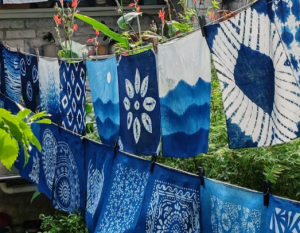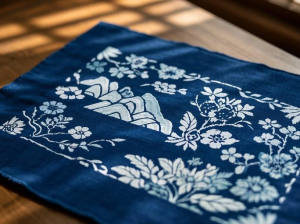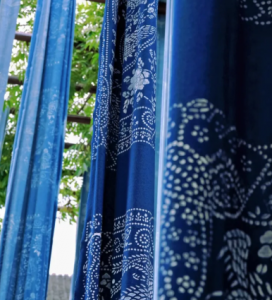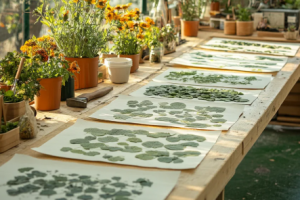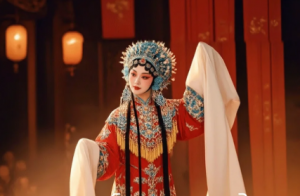In the realm of Chinese textile heritage, few art forms possess the quiet elegance and enduring appeal of Indigo Blue Print (蓝印花布, lán yìn huā bù). With its pure, contrasting hues of deep indigo and natural white, this traditional resist-dyeing technique has clothed generations of Chinese people, transforming everyday fabric into a canvas of cultural symbolism and rustic beauty.
Historical Roots: From Folk Craft to Cultural Treasure
The origins of blue print cloth trace back over millennia, evolving from ancient Chinese dyeing traditions into a distinctive folk art form.
-
Early Beginnings
The earliest evidence of indigo dyeing in China dates to the Qin and Han dynasties (221 BCE–220 CE), with the foundational resist-dyeing technique known as xie (缬) documented as early as the Northern and Southern Dynasties (420–589 CE). The renowned Tang Dynasty poet Bai Juyi even referenced “blue print cloth” in his poems, suggesting its widespread recognition. -
Song Dynasty Advancement
During the Song Dynasty (960–1279), the technology of woodblock printing significantly advanced blue print techniques. The Yingzao Fashi—a Northern Song architectural treatise—included official records of “medallion pattern” blue prints, indicating its use in decorative arts. -
Ming and Qing Popularization
The true flourishing occurred during the Ming (1368–1644) and Qing (1644–1912) dynasties, when blue print cloth became ubiquitous in everyday life across China. The Jiangnan region—particularly Nantong in Jiangsu province—emerged as a production hub, with the distinctive blue and white patterns adorning clothing, quilts, door curtains, and household items.
The Alchemy of Blue: Materials and Crafting Process
The creation of traditional blue print cloth is a meticulous, multi-stage process that transforms plain white cotton into works of art through natural materials and skilled hands.
Key Materials:
-
Natural Indigo: Derived from the fermented leaves of the indigo plant (Persicaria tinctoria)
-
Resist Paste: A mixture of soybean flour and slaked lime
-
Hand-Carved Stencils: Typically made from oiled paper or laminated mulberry paper
-
Cotton Cloth: Handwoven, sturdy cotton fabric
The Production Process:
-
Pattern Carving (刻花)
Artisans skillfully carve intricate designs into stencils using specialized cutting tools. Traditional patterns include floral motifs, animals, children at play, and auspicious symbols—each carrying specific cultural meanings. -
Paste Application (刮浆)
The carved stencil is placed atop the cotton fabric, and the resist paste is scraped across its surface. Where the pattern is carved, the paste passes through to the cloth beneath, creating a protective barrier against dye. -
Indigo Dyeing (染色)
The paste-covered cloth is immersed in the indigo dye vat multiple times—a process requiring experienced judgment. Each dipping is followed by oxidation in air, where the fabric magically transforms from green to blue as the dye reacts with oxygen. -
Paste Removal (刮白)
After dyeing, the cloth is dried and the resist paste is scraped away, revealing the pristine white patterns against the deep blue background. -
Finishing (整布)
The fabric is washed, stretched, and sun-dried, achieving its final brilliant contrast between blue and white.
Patterns with Meaning: The Language of Blue Print
Blue print designs form a visual vocabulary of Chinese folk symbolism:
-
Butterflies (蝴蝶): Representing longevity and marital happiness
-
Peonies (牡丹): Symbolizing wealth and honor
-
Lotuses (莲花): Embodying purity and spiritual ascent
-
Carp (鲤鱼): Signaling success and perseverance
-
Pomegranates (石榴): Denoting fertility and abundant offspring
These patterns reflect the collective aspirations of ordinary people for fortune, happiness, and prosperity—a democratic art form that brought symbolic meaning to everyday life.
Regional Variations: A Tapestry of Local Styles
While blue print traditions existed throughout China, several regional styles achieved particular renown:
-
Nantong Blue Print (南通蓝印花布)
Renowned for its elegant, refined patterns and superior craftsmanship, Nantong became the epicenter of blue print production during the Qing Dynasty, with its techniques eventually recognized as national intangible cultural heritage. -
Hunan Blue Print (湘西蓝印花布)
Characterized by bold, graphic patterns influenced by ethnic Tujia and Miao minority aesthetics, featuring stylized animals and geometric designs. -
Zhejiang Blue Print (浙江蓝印花布)
Notable for its delicate, intricate patterns often inspired by Jiangnan water town landscapes and literati culture.
Modern Renaissance: From Tradition to Contemporary Design
The late 20th century saw blue print cloth facing near extinction as industrial textile production dominated. However, the 21st century has witnessed a remarkable revival driven by cultural preservation efforts and innovative adaptations.
Preservation Initiatives:
-
UNESCO Recognition: Traditional indigo dyeing techniques were inscribed on China’s national intangible cultural heritage list in 2006
-
Master Artisans: Practitioners like Wu Yuanxin have been designated as “inheritors” of the craft, dedicated to preserving traditional methods
-
Museum Collections: Institutions such as the Nantong Blue Print Museum work to document, preserve, and exhibit historical examples
Contemporary Applications:
-
Fashion Innovation: Designers are incorporating blue print patterns into modern clothing, accessories, and home decor
-
Cultural Products: Museums and designers collaborate to create blue print-themed merchandise that appeals to younger consumers
-
Architectural Integration: Blue print elements appear in interior design, hotel decor, and cultural spaces
-
Global Dialogue: International fashion houses and artists have drawn inspiration from this traditional technique, creating cross-cultural conversations
As Shanghai-based designer Zhang Na observes, “Blue print cloth possesses a unique aesthetic that transcends time—it’s both ancient and utterly contemporary in its minimalism and sustainability.”
The Future of Blue: Challenges and Opportunities
While blue print cloth has experienced renewed interest, its preservation faces significant challenges:
-
Aging Artisans: The average age of master craftspeople continues to rise with few young apprentices entering the field
-
Economic Viability: The labor-intensive nature of traditional production makes it difficult to compete with machine-printed alternatives
-
Material Sourcing: Natural indigo cultivation has declined in favor of synthetic substitutes
Yet opportunities abound through sustainable fashion movements, cultural tourism, and educational programs that introduce blue print techniques to new generations.
Conclusion: The Enduring Poetry of Blue
Indigo blue print cloth represents more than a textile technique—it embodies the wisdom, aesthetics, and spiritual world of traditional Chinese culture. In an age of mass production and synthetic materials, its natural dyes and handmade quality speak to contemporary desires for authenticity and sustainability.
The rhythmic process of dyeing—the repeated dipping and oxidation—mirrors the patient accumulation of cultural heritage itself. Each piece of blue print cloth tells a story not just of patterns and techniques, but of human hands working in harmony with nature’s rhythms.
As this ancient craft continues to find new expressions in the modern world, it remains a testament to the enduring power of traditional wisdom—reminding us that some of the most profound beauty emerges from the simplest elements: cloth, paste, and the magical transformation of leaves into lasting blue.
猜你喜欢
发表评论
电子邮件地址不会被公开。 必填项已用*标注
